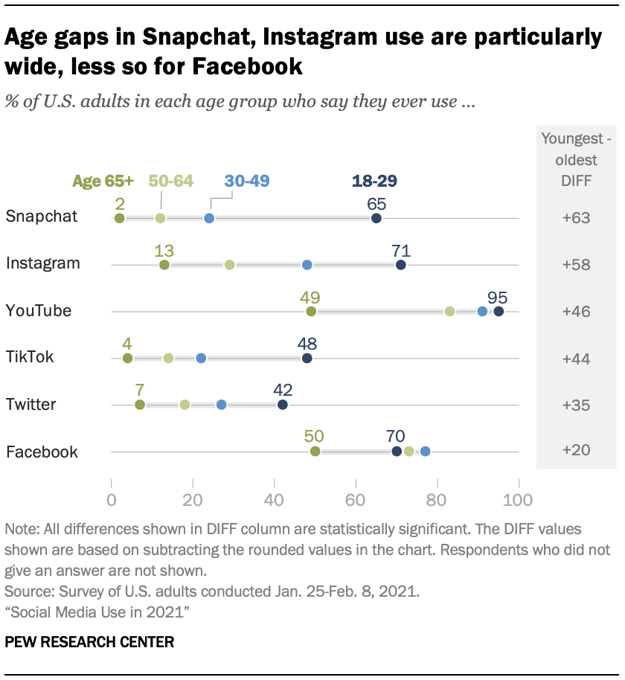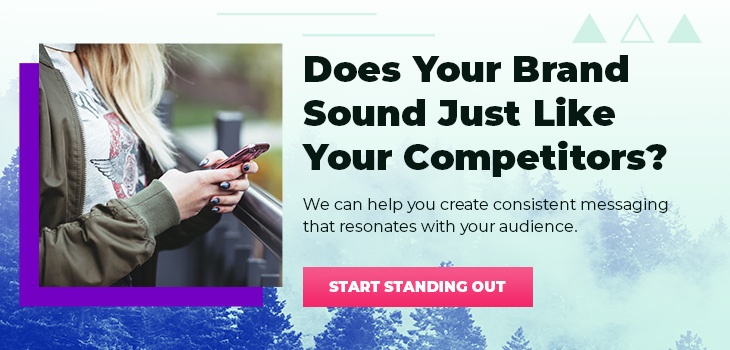You can’t ignore content. It’s the backbone of every strategy, every campaign, every tactic that brings customers into your business, builds trust and develops relationships. Content creation has increased 207% since the pandemic, which is great for businesses because it also produces three times more leads than outbound and costs 62% less.
But where does it fit into your overall strategy? Too many people try to silo content from their overall marketing efforts instead of integrating it into their approach. Content can support campaigns, drive initiatives and shape your positioning in the marketplace.
That’s why it’s a key component of success. However, we will admit that implementing content marketing can be a tough nut to crack, especially if you’re just starting out. So in this post, I’ll walk you through the current content landscape, different aspects of your business that need content and how to put your content strategy into practice.
The Market is Changing
Baby Boomers were a big generation and thus have dominated the majority of market consumers for quite some time. But now that the tail end of this generation is reaching retirement age, a new group is gaining a majority in the market.
Enter Millennials. That’s right, the social media-loving, cell-phone toting, tech savvy generation is pushing in as the leading age group of consumers in the U.S. This is part of the reason digital marketing has seen such a big push in recent years, and a big reason you should be investing in a content marketing strategy.
You see, that “social-media loving” moniker isn’t a joke. It’s true. Millennials use social media platforms not only to connect with friends and family, but also to research your brand. It’s a primary information source when they want to learn more about a business, even before they find your website or read your blog posts.
The graph below from Pew Research Center shows the percentage of people who use social media by age group.

This is just a glimpse into people’s online activity, but it’s an example of the informed world we live in. Just like blind dates are pretty much a thing of the past, people aren’t choosing brands without learning about them first anymore. That’s where your content comes in.
Content marketing provides materials to explain your industry, product and services to potential customers. Although I focused on social media in the above example, keep in mind that content can mean a lot of things — social media, blogs, video, email, newsletters, white papers, etc. All of these provide unique opportunities to position yourself as an authority in a niche space. This can bolster brand awareness and encourage leads to dive further into your content, eventually guiding them all the way through your sales funnel.
4 Ways Content Supports Your Digital Strategy
You can see the value that high-quality content has on its own, but that’s not where its true power lies. In fact, the real value of content is how it supports other areas of your business.
#1 Brand Building
Let’s start by looking at what content can do for your brand. For one, it can build consumer trust, which helps improve your brand’s reputation, credibility, and authority — and the numbers prove it. Seventy-eight percent of consumers report they prefer to read engaging, knowledgeable articles over simply viewing and clicking ads.
On top of building trust, content is a great way to build brand awareness. You can get your company name and URL in search results, on social feeds, in YouTube results and more. While you're at it, you’re also establishing your brand’s personality and asserting it as a unique voice in your field.
Finally, content gives you a platform to spotlight your company’s subject matter expertise. It’s the tool you use to establish your brand as an industry leader and influencer.
You might be thinking, “Okay, Leah. All this sounds well and good in theory, but how do I actually put all of that into practice?”
A content strategy that strengthens your brand’s presence and authority requires three steps:
- An assessment of where your content is today.
- A decision on where you want it to be.
- A plan for how you’re going to get there.
The “how you’re going to get there” part involves things like establishing a style guide, defining your voice and building a content calendar, which help you conceptualize and strategize where your content will be most helpful.
As you progress through the content creation workflow, you’ll naturally incorporate those established brand elements into your content. Over time, as your content gets more views, the consistency of your messaging will solidify your image as a brand. That image is associated with the authority you establish throughout your content and will become the symbol of your brand as a trustworthy thought-leader.
#2 Long-Term Lead Generation
With traditional marketing strategies, you work within finite boundaries. The campaign starts on Day One, runs for a few weeks and ends. You can pull all your data, count your chips and see if you came in over or under. It’s clean, concise and confined.
Content marketing isn’t like that. It’s a long game. And that’s a good thing! Once you publish a piece of content, it’s there to stay. It’s always around for people to find and engage with, and if it goes stale, you can update it and republish.
The trick is knowing how to turn content viewers into content do-ers — a.k.a. leads. The easiest way to do that is to include a downloadable piece of content that adds value to the information in your post. This could be a guide, a template, a checklist, whatever fits the situation. It will live on a landing page and, in exchange for a few pieces of information, your viewers can download it and reap the benefits of your knowledge.
There is one caveat to this technique, and it’s the downfall of many well-meaning marketers.
Content marketing is not a set-it-and-forget-it tactic.
Yes, it will run in the background. Yes, it will continually support other efforts. But that doesn’t mean you can put Baby in a corner.
It’s important to monitor your content’s metrics so you can see which pieces are performing well and which are missing the mark. Include regular analytics checks in your content marketing plan and an annual audit to ensure that your posts are still relevant and resonating with your target audience. If they aren’t, take steps to evaluate and update the content.
#3 Search Engine Optimization (SEO)
Content is the bedrock of your SEO strategy, which is a crucial part of any digital marketing effort.
Many people think of SEO only in terms of content marketing. You add keywords to blogs and it makes them more discoverable, driving organic traffic to your website. From there, you hope they choose to explore more pages, download your lead generator or take some other action.
Although this is true, it’s not content’s only role with SEO. As your content climbs in rankings, Google starts to recognize that you’re an authoritative source users trust. This, in turn, raises the SEO value of your entire website because you’ve proven that you’re a reliable source of information.
The more effective your content strategy and SEO are, the more eyes will see your work and the more your company will become known as a key player in your industry.
So how do you optimize your website and content for SEO?
- Collaborate with your sales team to determine topics people want to learn about
- Perform keyword research and write articles around relevant topics
- Rely on internal SMEs for expert insights
- Follow on-page SEO best practices
#4 Sales
That’s right, your sales team needs content too. More website traffic creates new leads and new leads means more warm prospects for your sales team to talk to.
However, we all know that rarely (if ever) is someone ready to purchase the first time our salespeople reach out. They’re usually still early in their customer journey and need a bit more nurturing, which is where your content steps in again.
You can create high-quality content specifically for the sales process or use assets you’ve already published on your website. The goal for this type of content is to address common questions, concerns and objections that your sales team face in their conversations. You need pieces that educate while also establishing trust and confidence in your product or service.
Some specific pieces that are often helpful include:
- Case studies
- Comparison statistics
- Testimonials
Your sales team can send these assets to potential clients during conversations, in follow up emails or even in automated sales sequences. They’re a convenient and effective way to move people further into your sales funnel and have more meaningful conversations about the problems you can solve.
Quality Over Quantity
Content is like a Magic Grow capsule. You drop it one piece in water and it quickly grows into a hundreds-deep backlog of blogs. The good news is that now you’ve got tons of content working for you! But that high content count can have a sneaky side effect.
It’s important to remember throughout the content process that quality should never be sacrificed in the name of quantity. It can be easy to get swept up in all the pages you could create, but you need to focus on what you should create.
Simply churning out mass amounts of poorly written or un-optimized content will not benefit your business. The lack of usefulness and professionalism will hurt your brand’s reputation, won’t help you nurture customer relationships and could even damage your SEO rankings.
To engage your audience and drive them toward conversion, ensure the content you produce is well-written, highly relevant and highly valuable — no typos, no fluff pieces, and, as counter-intuitive as it sounds, not too salesy.
People want to engage with content that helps them get from point A to point B. Give the people what they want, and they’ll return the favor.
Put It In Practice
All of this brings us ever closer to the big questions: What content should you create and how should you distribute it? The seemingly endless possibilities can quickly become overwhelming — blogging, videos, podcasts, infographics, listicles and social media posts are all possible mediums for your content.
What makes the most sense for one company may be a terrible approach for another, so you need to do some research to figure out what types of content will support your brand’s goals.
The best advice I can give is that you focus first on what you want to accomplish for your brand and then on how content can support it. Once everyone is aligned around the purpose, it becomes much easier to figure out topic matter and distribution.
To see this advice in practice, check out our case study about how we grew our organic traffic from 100 to 7k monthly sessions.







